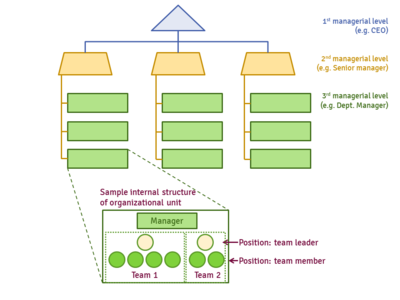Principles and features of organizational structure: Difference between revisions
From CEOpedia | Management online
(Infobox update) |
|||
| Line 17: | Line 17: | ||
==Basic elements or organizational structure== | ==Basic elements or organizational structure== | ||
[[File:organizational_structure.png|400px|right|thumb|Fig.1. Elements of the organizational structure]] | |||
Elements of the system are: position, the cell, an organizational unit. | Elements of the system are: position, the cell, an organizational unit. | ||
* '''Position''' - the smallest element in the [[organizational structure]] characterized by: | * '''Position''' - the smallest element in the [[organizational structure]] characterized by: | ||
Revision as of 14:41, 27 August 2020
| Principles and features of organizational structure |
|---|
| See also |
Organizational structure as set of elements of an system with established connections between them, should be created according to several principles
Basic elements or organizational structure
Elements of the system are: position, the cell, an organizational unit.
- Position - the smallest element in the organizational structure characterized by:
- The name (referred to by the symbol for easy identification in the whole structure)
- The tasks, powers and responsibilities,
- A place in space
- Equipment (in machinery, equipment, means of work and instructions)
- Established relationships with other organizational positions
- Organizational cell - a team consisting of a human supervisor and subordinate team members, the purpose of implementing, harmonized with the objective of the organization
- Organizational unit - a collection of cells under the direction of a supervisor
- Organizational ties are the relationships that occur between elements of structure relevant to the objectives of the organization. Types of ties:
- Hierarchical defined as the relationship of subordinate and supervisor. The essence of these ties are superior powers to determine the tasks to subordinates
- Functional - exist between organizational units or individual employees. Express themselves in assisting and advising in the performance of tasks.
- Technical - expressed through the mutual dependence of the members of the team, the result of the division of labour in the performance of a product or a common goal.
- Information - determined the flow of information and involving the obligation of unilateral or mutual information.
Principles of construction of organizational structures
- The principle of expediency determines the need for a clear and explicit definition of objectives, both for the entire company, as well as for each of its sub-systems, including the individual positions.
- The principle of the division of general goal. In accordance with the principle of expediency main goal is divided into general objectives for the purposes of sub-to the point where they can be assigned to individual units. On the basis of this division is the grouping of individual positions in the cell and major organizational units, which are assigned a higher level of sub-goals.
- The principle of specialization: Organizational units should be grouped according to homogeneous tasks identified in the process of division of the overall objective. Grouping criteria can be: technological specialization (similar tasks), specialization in object (similar item of work)
- The principle of the balance of tasks, allocation of powers and responsibilities specific tasks must be associated with the simultaneous granting of appropriate powers (competence). At the same time managers should apply for the position responsibility for the proper performance of duties, which corresponds to the assigned tasks and powers.
- The principle of one-man management. Efforts should be made to the hierarchical subordination of each job to a single manager.
- The principle of determining the boundaries of supervision refers to the need to establish a reasonable size of the team, which can be managed by a single manager.
- It comes down to determining the optimal span of leadership and management coverage analysis for each executive position. The span of management depends on: the level of qualifications of the manager and the team, the nature of the tasks assigned to workers, the degree of organization of the system, the distribution team, the competence and the degree of independence of employees, the efficiency of the communication system
Basic functions of the organizational structure
- It is a tool of management.
- Integrates system components in an integrated whole.
- Provides a relative inner balance, to prevent the destruction of the system.
- Provides spatial and temporal coordination of processes implemented in the system.
- Reduces the probabilistic nature of the system, which is a consequence of variability of its operation.
- Ties system with its environment, so exchange can be realized
- It plays an adaptive role due to the integration of the system components that control the environment and adapting them to the needs of the system.
Factors shaping organization structure
- External economic conditions of operation, features external to the organization management system, environmental conditions, demographic, political, legal, and others., The development of information technologies, the development of methods and tools for managers
- Internal: history and the creation of the organization, the size of the organization, the organization's objectives, applied technology, the social system, the company's strategy: mission, vision, strategic objectives
See also:
References
- Miles, R. E., Snow, C. C., Meyer, A. D., & Coleman, H. J. (1978). Organizational strategy, structure, and process. Academy of management review, 3(3), 546-562.
- Pugh, D. S., & Hickson, D. J. (1976). Organizational structure in its context. London: Saxon House.
- Scott, W. R. (1995). Institutions and organizations (p. p-33). Thousand Oaks, CA: Sage.
